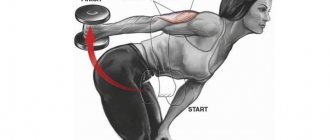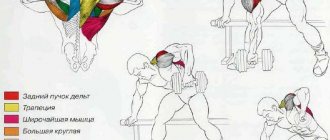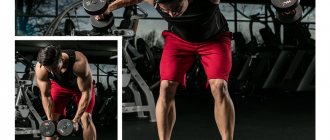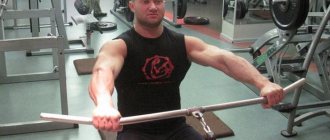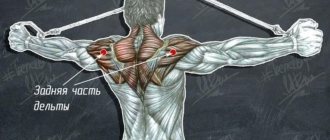Bent-over dumbbell raises
| Effect on muscles: Shoulders: Rear deltoid Back: Small round Back: Diamond-shaped Trapezoid: Trapezoidal Triceps: Middle fascicle |
Description
By performing this exercise, you provide the back head of the deltas with an isolated load, thereby giving this bundle of muscles a lumpy shape, allowing it to be clearly distinguished from the background of other back muscles.
Bent-over dumbbell raises will help you improve your athletic performance if you are involved in swimming, gymnastics, rowing, archery, volleyball, tennis and wrestling.
Exercise technique
Take a dumbbell in both hands with such a grip that your palms are facing each other. You need to lean forward so that your torso is parallel to the floor. Keep your back straight and slightly arched at the lower back. You can bend your knees slightly if your muscles in the back of your thighs are tight. The main thing is that the S-shaped curve of the spine is tightly fixed. If you are unable to maintain the natural curve of your spine, use a horizontal bench. You need to position yourself on it in such a way that almost your entire chest “crawls out” over its edge, and your legs rest firmly on the floor.
The dumbbells should hang on straight arms, under the chest. The hands must be firmly fixed at the elbows until the end of the approach. They can be bent a little before you start the exercise - this is the starting position. It is unacceptable to bend and unbend them during the approach. All movements should occur exclusively in the shoulder joints, all other parts of the body should remain motionless.
After inhaling and holding your breath, tighten your rear deltoids and trapezius as much as possible, then smoothly move the dumbbells to the sides, trying to lift them as high as possible
Particular attention must be paid to ensuring that the arms move only in a vertical plane that passes through the shoulders; the dumbbells cannot be moved either back or forward. At the top point, the elbows should be higher than the level of the back
Exhaling, begin to smoothly return the dumbbells to their original position. Take a short break and begin the next repetition.
Recommendations
Throughout the entire exercise, the back should remain straight and slightly arched in the lower back. Even the slightest rounding of the back carries the risk of injury. Remember to hold your breath when you open your arms; this will not only stabilize your torso, but will also give you additional strength.
In order for the load on the rear deltoids to be maximum, in the starting position the shoulders should be lowered, and the dumbbells should be raised each time above the level of the back, as much as possible. In this case, the shoulder blades cannot be brought together. If you want the main load to fall on the rhomboid muscles and middle trapezius, and also to achieve their maximum contraction, then be sure to bring your shoulder blades together at the top point.
Don't use dumbbells that are too heavy for this set. They will prevent you from doing the exercise technically correctly and increase the risk of injury. Arms should be straight or slightly bent at the elbows
Take into account: the more your arms are bent at the elbows, the shorter the range of motion will be and the less load will be placed on the rear deltoids
One variation of this exercise is crossover flyes. You need to place the bench in the middle of the crossover so that the shoulders and lower blocks are in the same vertical plane. Attach handles (D-shaped) to the cables that pass through the blocks and perform pull-ups by crossing the cables. But, performing the exercise in a crossover, and not with dumbbells, you will not be able to work the muscles in full amplitude, due to the fact that the crossing cables will not allow you to raise the handle above shoulder level.
Another variation of the exercise is the one-arm fly in a block machine while kneeling. You need to get on all fours, rest one hand on the floor and bend it slightly so that the shoulder of one hand is raised (otherwise, when returning to the starting position, the hand will cling to the floor) - this position will be the starting position for this variation of the exercise .
Bent over swings while sitting on a bench
For those who find it difficult to swing dumbbells to the sides while bending over in a standing position, an easier option was invented - sitting on a bench. It places your torso on your knees (literally).
The technique is like this:
- Find a bench, take small dumbbells.
- Sit on the edge facing the mirror. Bring your knees together.
- Lean forward with your back straight. Reach your chest to your knees and stop in this position.
- Your chest rests on your lap. In this pose, you reach 60–70 degrees of inclination relative to the plane of the floor.
- From this position, you will reach your hands to the floor. That is, the dumbbells are on the floor on either side of you.
- Take them and begin to lift them, trying to turn your elbows towards the ceiling. Without this, you will download something else.
- Do 3-4 sets of 10-12 reps. Don't forget to warm up well before the exercise. The rear deltoids can also be pulled. The muscle is small, but the force it creates is quite large.
Don’t forget to breathe correctly when doing dumbbell swings while sitting: when we raise our hands, we exhale, when we lower them, we inhale.
In this position, the knees press on the chest, making it difficult to breathe fully. Therefore, try not to lie completely on your knees.
Bent over dumbbell swings to the sides
Isolated practice on pumping the rear head. All lifts behind the back load the deltoids, but the posterior bundle usually does not receive a concentrated load and lags behind in development. Athletes purposefully work it out on the horizontal bar or with bent over swings.
Active muscles: middle delta, rhomboid, trapezius, infraspinatus, teres minor. The technique is performed with both hands or one while standing and sitting. In the second case, you won’t be able to bend down to a clear parallel with the floor, so the load will shift to the middle head.
- IP - basic (previous). Bending at the waist, tilt the upper part of the body until it is horizontal with the floor. If the joints are flexible enough, we bend lower. A low start will “turn off” the trapezius, shifting all the tension to the deltoids.
- Keep your back slightly rounded. It is in this position that the rear head fully works.
- With elbows bent, we pull the shells up and to the sides, trying to get them further behind our back. At the end point they should not be higher than the deltoids.
- We linger in the top position for a couple of seconds, feel an intense muscle contraction, and return to the starting position.
Subtleties of weight selection
For the first workout, you need to take the smallest weight available in the gym. Usually it is 1–2 kg. Don’t be shy – your task is to develop the technique. And all this is worked out on light weights.
For the second workout, that is, in a week (it is better to train the rear deltoids once every 6-7 days). You will already take 3-4 kg. In the first month it is better not to chase the scales, as well as later. Work in a way that makes you feel comfortable. Let your body remember the necessary movements.
When adding weights, make sure that the dumbbell raises are performed correctly! If your arms begin to bend more, you cannot move them to the desired position - the weight is heavy.
This is an isolated shoulder exercise and is not a strength exercise. That is, regardless of whether you do bent-over dumbbell flyes with 15 kg dumbbells or 5 kg, your task is to do everything efficiently and get the maximum benefit. Then the effectiveness will be maximum.
If you don’t have back problems and have good stretching, then do bent-over dumbbell raises while standing. The sitting option is more comfortable, but relaxes your back.
Sitting dumbbell raises, exercise technique with photo
Execution technique
- Sit on a bench with your feet together. Take dumbbells in your hands and rest your chest on your knees. The starting position is when your arms are bent and your elbows are spread out to the sides, and your hands are not in contact with your shins.
- From the starting position, we begin to move our arms upward. The position of the hands when performing the movement: with the ends of the palms to the sides. When you reach the top point, you can make a short-term fixation in this position.
- Then we smoothly lower our hands down, but do not bring them to the shins.
- By analogy, we perform the planned number of repetitions
The recommended number of repetitions is 12-20 repetitions.
How to properly perform dumbbell lateral raises while sitting or standing at an angle
Notes
- As already noted, dumbbell lateral raises while sitting are an exercise that can be performed by analogy in a standing position in an inclined position.
- The arm is slightly bent at the elbow joint and is fixed in this position during the entire exercise. This will allow maximum load on the rear delta. Otherwise, the trapezius and other muscles may be more actively involved in the work.
- When raising dumbbells to the sides while sitting or bending over, do not lose sight of the position of the hands. It is better when the ends of the palms are directed to the sides. If you try to turn the ends of your palms a little forward, the rear delta will engage in work even more productively.
- In order to make it easier to control the technique of performing dumbbell raises to the sides while sitting or bending over while standing, you need to direct your concentration specifically to your elbows. That is, try to bring your elbows, not your hands, to the top point of the exercise.
- When lowering your hands to the lowest point, it is not recommended to pause. The rear delts will receive a much greater response if, upon reaching the bottom point, a force is immediately developed leading to a reverse movement, that is, an upward movement.
- When lowering your hands to the lowest point, you should not touch your shins. It is better to leave a small gap between the hands and shins of 10-15 cm.
- It would be very justified to reduce the working amplitude of dumbbell raises to the sides. If you lower the dumbbells down at a much smaller interval, that is, 20-30 cm short of the shin, the rear deltoids will receive an even greater load, since throughout the approach they will be in a state of continuous contraction, without stopping from work. In this case, the exercise is most often performed in a forced style. You may want to experiment with this variation of seated dumbbell lateral raises to see if this style works for you.
- At the top point of the amplitude of dumbbell extensions to the sides, it will be very useful to do a short-term fixation.
- Dumbbell raises to the sides while sitting or standing in an inclined position can be performed both with small weights in a concentrated style, and by resorting to more significant weighting of the working apparatus. These two options can be combined from workout to workout, or you can use both styles in one, for example, warming up with a light weight in a concentrated style, then with a heavy weight, and at the end “building up” concentrated sets with a small weight.
Preparation for execution
One of the key points before starting an exercise is warming up. For this purpose, it is recommended to make several circular movements with your shoulders in both directions. Then perform a series of 15-20 arm raises in training mode with a weight of 2-3 kg in each hand.
Technique:
- The distance between the feet is 50-60 cm;
- When performing the exercise, the body should be slightly tilted forward, gaze directed forward;
- Control the vertebral line - it should be straight;
- The hands are in a semi-relaxed state;
- Bend your arms slightly at the elbow joint, so as to give your palms a direction “to the floor”;
- You should keep the pace slow;
- Hands with dumbbells must be raised slightly above shoulder level in a vertical plane;
- Upon reaching the peak of muscle contraction, fix your hands for 2-3 seconds;
- Lower your arms under control smoothly to the starting position;
- Before starting the exercise, take a deep breath and, at maximum load in the positive phase, hold your breath; when lowering your arms, exhale.
Lifting dumbbells on an incline to work the rear beam is performed in accordance with the same rules, only the body is bent at an angle of 90 degrees, and the knees also need to be bent a little. It is very important when performing this type of lifting to pull the dumbbells with your shoulders and not your back.
Particular care should be taken to determine the ideal load. To select the optimal weight of dumbbells, it is necessary to perform 12-15 lifts with the expected working weight without compromising the technique of performing the exercise.
Common beginner mistakes:
- Excessive or insufficient body tilt;
- Rocking;
- Using heavy weights;
- Lack of control over the pace of the ascending and descending phases;
- Strong bending of the elbows.
2 more options
In addition to the classic one, there are 2 more variations of this movement.
Standing (head on the bench)
The classic bent over dumbbell lift - without a support point, is suitable for physically developed athletes. For those who have recently started exercising in the gym, this option is not suitable and can even be traumatic. since it involves excessive stress on muscles and joints.
In this case, a more suitable option is to rest your head on the upper part of the back of the gymnastic bench. This allows you to relieve stress from your back and neck
which is a very important part of staying safe while exercising
- Stand on an incline bench with dumbbells in each hand. Palms facing each other. Bend your legs slightly at the knees, straighten your back.
- Rest your head against the support. By the way, this can be not only the upper corner of the bench, but also a wall - the main thing is that the body position is stable.
- Bend your arms slightly at the elbows and lower them. In this case, the torso is parallel to the floor, but it can be positioned differently - let’s say an angle of forty-five degrees.
- Raise and lower your arms smoothly. Control the position of the dumbbells relative to the body - they cannot be moved forward or backward.
- Raise the dumbbells and smoothly move them to the sides. In this case, the arms remain slightly bent at the elbows. You should not round your back, as this will cause improper distribution of the load and may damage your lower back.
- At the maximum point, raise your elbows higher than your back. We lower and raise our arms without sudden movements, the planned number of times. Ideally, these are three sets of twelve to fifteen repetitions.
Watch the video for more details:
Many people want to start their first classes with heavy dumbbell weights in order to quickly achieve the desired result. But we don't recommend this approach. When choosing the weight of dumbbells, consult a trainer, as this is an individual parameter for everyone. If you overdo it with weight, you can get sprains and even more serious injuries.
This option makes maximum use of the rear and middle deltoids, triceps, biceps, and trapezius. The deltoids of the shoulders should receive the maximum load, for this, try not to squeeze your shoulder blades when raising the dumbbells.
Bent over dumbbell swings
This type of load perfectly pumps the rear deltoid muscles of the shoulders. The trapezius and rhomboid muscles of the back are also involved. This type of load strengthens the shoulder joint, thereby reducing the risk of injury.
- Choose dumbbells of your usual weight. Take them in your hands, bend your elbows. Position them so that they are near your shins.
- Bend your body towards your knees. Place your feet slightly wider than shoulder width. Your position should be stable and comfortable.
- Smoothly spread your arms out to the sides parallel to the floor. At the maximum point, you need to hold your hands for two seconds and return to the starting position.
Increase the number of repetitions gradually, from lesson to lesson. Excessive stress can lead to sprained ligaments.
Attention! Doing dumbbell swings is a fairly strenuous exercise and is not recommended for beginners. First you need to strengthen your physical fitness, and then proceed to exercises of a higher level of load and complexity.
By practicing the listed types of swings with dumbbells, you ensure that your shoulders become rounded and prominent. By alternating different swing methods, you diversify your physical activity and quickly achieve the desired figure parameters. These exercises are paramount to developing beautiful shoulders. By doing them regularly, set a goal for yourself, and you will definitely achieve it.
About technology
There is hardly any need to repeat how important technique is in bodybuilding. Therefore, you first need to learn how to correctly lift side dumbbells in a forward bend with light weights, and only when the technique is fully mastered, gradually move on to heavier equipment.
The order of swings should be as follows:
- Take dumbbells (neutral grip) and tilt your torso forward until it becomes parallel to the floor. For greater stability, bend your legs slightly at the knees and keep your back straight. This is the starting position.
- As you exhale, smoothly, without jerking, raise your arms with dumbbells, slightly bent at the elbows, to the sides so that they reach shoulder level and are parallel to the floor. It is important that your thumbs point straight down, this will allow the rear deltoids to be loaded to the maximum.
- At the top point of the movement, we pause for a second and strain the target muscles as much as possible, then, while inhaling, we lower our arms down along the same trajectory.
- Immediately, without pausing, we again raise our arms with dumbbells.
- If you wish, you can rest your head against the support when performing lifts.
Swing dumbbells to the sides while standing, bending over and sitting; execution technique
The deltas and trapezius are responsible for the shape of the shoulders. To make the figure resemble a triangle, you need to increase the volume and give the muscles a defined relief. Due to anatomical features, the shoulder girdle develops slowly. There is no technique that evenly loads all 3 deltoid bundles. Basic practices include 1-2 heads, trapezoids, and isolating ones are focused on local load.
In order to properly build a training program, in addition to the main exercises, we include targeted exercises with alternate shifting of tension from the bundles. For beginners, 2 techniques are enough, for athletes - 2 basic and 3 isolating.
The best basic practice is wide grip rows. After this, we move on to swings, which help strengthen and stabilize the joints and develop the middle and rear heads.
Benefits of dumbbell bent over flyes
By doing this exercise, the athlete receives the benefits that are listed below:
- All delta heads receive very regular development, which can be called harmonious;
- The athlete boasts more rounded shoulders;
- The upper back is well strengthened;
- The ratator cuff, which is very easily injured during such training, is very fully strengthened;
- Thanks to this exercise, the deltoid muscles are less susceptible to injury.
This exercise is an isolating exercise, but despite this it plays a very important role in the structure of the body and is very useful.
Features of the exercise
To better understand how to train your shoulders, you need to understand the functions they perform. There are two of them:
- Push the weight away from you (standing press, dumbbell press),
- Pull the weight towards you (swing to the sides, pull to the chin).
The rear delta is very difficult to develop for the reason that there are not many exercises that specifically load it. The difficulty also lies in the difficulty of including it in work in isolation from other muscle groups.
Do you agree that a developed rear delt looks impressive?
Bent over dumbbell swings are an isolated exercise (only the shoulder joint works, the elbow joint is fixed). By tilting the body and abducting the arms to the sides, isolated work of the rear deltoid is achieved.
The difficulty of the exercise lies in the inability to turn off the auxiliary muscles and work only with the rear deltas, in the incorrectly selected working weight, the “clumsy” technique of execution, and the inability to feel the contraction of the rear deltas.
The main mistake many people make is performing bent over swings using the trapezius muscle. This happens in cases where:
- in the starting position, the shoulders are high (trapezium tense),
- as the movement progresses, the shoulder blades retract, the shoulders actively move (raise and fall with the force of the trapezius muscle),
- the elbows extend above the level of the shoulders (the higher the elbows are in relation to the shoulders, the easier it is for the trapezius muscle to engage in work).
If we want to train the rear deltoid, then:
- in the starting position, the shoulders should be lowered down (the trapezius is stretched across the back),
- the movement should be carried out by the elbows, not the shoulders,
- The maximum height of the elbows is at shoulder level, not higher.
Despite the fact that the amplitude, when performed correctly, is small (in order to exclude auxiliary muscles from the work), loading the rear delta will be effective - such is its anatomy and physiology.
One of the options for performing tilted swings is lying on a bench
Bent over swings can be performed standing, lying on an inclined bench with your chest or sitting, also tilting your body forward, with one hand alternately or with both. Body tilt is necessary to create the correct vector of movement of the dumbbells and engage the rear deltoid in the work. Choose the optimal angle of inclination based on the design features of your body and the sensations of the rear deltoid (45° is suitable for some, while others will have to bend almost to the horizontal, look for what works for you).
In general, the tilt of the body and the position of your body are secondary, the really important things when performing are:
- slumped shoulders
- movement by raising the elbows no higher than shoulder level,
- turning of the hands when lifting.
Well, now more about the technology.
Execution technique[edit | edit code]
Hold a dumbbell in each hand and lean forward so that your upper body is parallel to the floor. In the starting position, the arms with dumbbells hang down. Turn your arms so that your thumbs point towards your body and the dumbbells are almost in line. Raise your arms through your sides up and slightly back, bending them slightly, until the dumbbells are at shoulder level or slightly higher. The little fingers should be higher than the thumb. Hold this position for a second and slowly and in a controlled manner lower your arms to the starting position. Complete the planned number of repetitions.
- Bent over side arm raises
- Bent over side arm raises
- Bent over side arm raises (variations)
Bent-over dumbbell raises
Why, to whom and when?
How to pump up your shoulders using bent over flyes? Before we begin describing the technique, let us briefly describe the exercise itself. The main muscle that bears most of the load when performing it is the posterior deltoids. It takes an active part in movements of the shoulder joint, such as abduction and backward swing. The development of this muscle zone very quickly affects the appearance of the athlete - it gives a relief “lumpy” to the back and additional volume to the arms when viewed from the side.
Bent-over dumbbell raises are one of the few isolation exercises that are equally useful for both experienced athletes and beginners who have recently started practicing bodybuilding. This is due to the fact that even a novice athlete with regular training will very quickly be able to notice the result in the mirror, and in addition this will also affect strength indicators in “traction” exercises.
In addition to its undeniable benefits in bodybuilding, the fly is an excellent way to combat slouching.
Performance technique
The key to high efficiency in performing any exercise is the correct technique. You can work with medium or even minimal weights, doing a high-quality approach, and achieve much greater results than when working with heavy weights, but the wrong technique. So, how exactly is it necessary to perform bent-over dumbbell raises:
- Stand straight, feet shoulder-width apart, dumbbells with a small (to begin with) weight in your hands, palms facing each other. Lean forward. Ideally, the body should be parallel to the floor - thus, the load on the rear deltoid muscle will be maximum. At the same time, lower your arms freely so that they are strictly perpendicular to the floor and located just under the chest.
- Now - movement. Smoothly begin to spread your arms to the sides, moving them only at the shoulder joint. The elbow must be fixed in the position in which the movement was started. Spread your arms as far as possible.
- At the top point, pause briefly, straining the rear deltas as much as possible. After this, smoothly begin to bring your arms back to the starting position until the dumbbells are again under your chest.
- Perform dumbbell flyes the required number of times.
Tips and nuances
Like any other exercise, dumbbell flyes have several very important and serious subtleties, knowledge and implementation of which will allow you to achieve maximum efficiency.
- Body position. As mentioned above, ideally the body should be parallel to the floor. However, not everyone’s muscles on the back of the thigh will allow them to assume this position, much less maintain it during the approach. Therefore, many athletes bend their knees slightly or perform the exercise while sitting. To do this, you can take a horizontal bench, sit on it and lean forward.
- Do not forget about fixing the elbow joint. While moving the dumbbells upward, he must remain motionless. Ideally, slightly bent, which will ensure maximum comfort and convenience when performing.
- Do not rotate the brush while performing. The correct option is that the palms are directed towards each other in the starting position, and look down at the top point.
- When performing the movement, do not contract your shoulder blades - this partially engages the back muscles, while unloading the deltoids.
- The arms at the shoulder joint should not deviate up or down - imagine that you just need to spread them to the sides, and do not deviate from this trajectory.
- You should not take the maximum weight, even for experienced athletes. The optimal number of repetitions per set is 8-10, so choose dumbbells based on these numbers.
I would also like to recommend the following articles:
- Reverse grip barbell curl
- Concentrated biceps curl
- Biceps on Scott bench
- Seated dumbbell curls
- Exercise "Hammer"
- Standing biceps curl
https://youtube.com/watch?v=RKnWZ4rjm7M
Technique: standing bent over fly
If all the benches are occupied, you can do the exercise while standing in front of a mirror. It is important that you see yourself in the reflection.
Take 2 dumbbells weighing 3-4 kg (believe me, if you are a beginner, this is more than enough).
- Stand at a distance of 1–1.5 meters in front of the mirror.
- Feet shoulder-width apart, feet parallel. Bend your knees slightly and lean your torso toward your hips. Keep your back straight, but do not raise your shoulders. The trapezoid should not be turned on. It is advisable to bend to an angle of 45–60 degrees relative to the floor.
- Fix your gaze straight, to do this, slightly raise your head up.
- The dumbbells need to be rotated so that their handles are oriented parallel to the feet. Bend your arms slightly at the elbows, fix the angle.
- Remember that your elbows will need to move upward. Therefore, when you start moving your arms to the sides, turn your arms so that your elbows are pointing towards the ceiling.
- Try not to squeeze your shoulder blades together - work purely with the posterior deltoid muscles.
- Raise your arms until they are parallel to the floor. Hold this position for 1-2 seconds and 5-10 seconds on the last repetition.
From the outside, you look like a bird flapping its wings.
Bent over dumbbell lateral raises are a very subtle exercise. Minor deviations from correct technique will render the training useless. Therefore, let's look at the most common mistakes and what can happen as a result.
Seven mistakes when performing dumbbell swings to the sides
Knowing these important points will allow you to master the correct technique and work the middle deltoid muscles in isolation.
Flexion of the elbow joints during movement
This is a fairly common mistake, which can be avoided if you create a small angle in the elbow joint in advance. It should be approximately 10-15 degrees. It must be saved until the end of the set being performed. At the point of maximum contraction, the angle is kept in the same way as at the very beginning.
Contraction and activation of the elbows balances the triceps. This deprives standing arm swings with dumbbells of their status as an isolated exercise. It ceases to serve the purpose for which it was included in the training process.
The dumbbells should not move in a completely straight line, but go in an arc. If the exercise is not done in front of a mirror, you can ask a partner or gym mate to check the correct execution technique.
Dumbbell lowered too low
To develop the middle deltoid muscles to the maximum, tension must be maintained throughout the entire approach. When the dumbbell in its extreme position is lowered to its maximum, being in front of the hips, the tension exerted on the deltoids drops to zero. To solve this problem, the range of motion is reduced by keeping weights at a distance of 10-20 cm from the body.
The correct choice of “distance” is evidenced by the more difficult process of lifting dumbbells, when the load falls on the middle beams. The main thing is to choose the right weight. If it is too heavy, the likelihood of injury increases many times over.
All attention should be focused on technique. When it is fully mastered, increasing the weight lifted will take place without any problems.
Throwing elbows in different directions
Disorderly and chaotic throwing is the most common mistake that beginner athletes make. The elbows in the swing are a kind of pointers, always located higher.
Missing the moment of correct movement of the deltas significantly slows down the process of development of the middle fascicles. To prevent this from happening, progress is rapid and of high quality, elbows should always play the role of pointers.
Limitation of hands in the top position
Most athletes limit themselves to raising their arms to shoulder height when performing swings. This position is not maximum, since the middle fascicles of the deltoid muscle can go higher. Increasing the height by another 45 degrees allows you to achieve maximum tension, which has a significant impact on the growth of the shoulder girdle. In addition, this movement gives impetus to the development of the upper trapezius.
There are some important points to consider. Athletes who are experiencing pain, injury or shoulder problems should first consult a doctor before making a decision as to whether the exercise can be performed at maximum load or not.
"T" position and locking
In the gym, you can often see how some athletes perform this exercise in such a way that in the upper position a semblance of the letter “T” is formed. This method leads to maximum stress on the elbow joints, as it negatively affects health.
Lift more weight by decreasing the bend angle
This is a misconception that many bodybuilders hold. The smaller the bend, the higher the weight lifted. However, given the main goal that the athlete pursues when performing swings, one should think about what is more important - technique or an illusory sense of one’s own strength. As the angle decreases, it certainly becomes easier to lift weights, including maximum weights.
A bodybuilder may think that lifting heavy weights makes him stronger, but this is not entirely true. The more time you spend building muscle, the better the training. Therefore, you should always remember that technique is much more important than just a feeling of your own strength without a significant increase in the volume and width of the middle delta beam.

